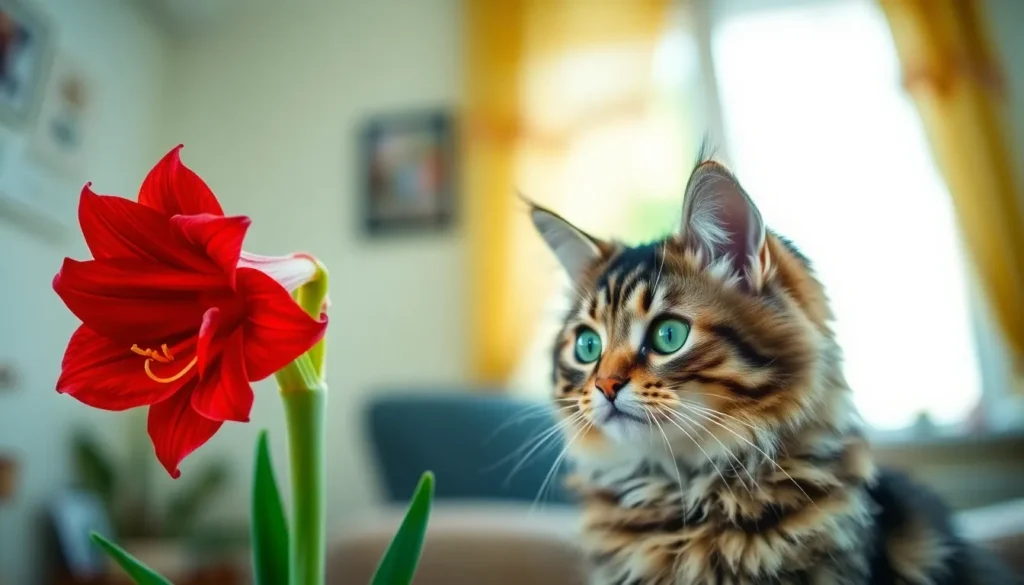Table of Contents
ToggleWhen it comes to sprucing up the home with beautiful blooms, amaryllis often steals the spotlight. Its stunning flowers can brighten up any room, but if there’s a furry feline roaming around, it’s time to pause and ponder. Is this vibrant plant a friend or foe?
Cat owners know their curious companions can turn into little explorers, sniffing and nibbling on anything that catches their eye. So, before letting your cat frolic around these gorgeous blooms, it’s essential to uncover the truth about amaryllis and its potential toxicity. Spoiler alert: your cat’s safety is no laughing matter, but that doesn’t mean we can’t have a chuckle while figuring it out! Dive in to discover if this lovely plant poses a threat to your purring pal or if it’s just a case of overprotective pet parenting.
Overview of Amaryllis
Amaryllis features striking blooms that brighten any space. This plant attracts cat owners’ attention due to its beauty and potential toxicity.
Characteristics of Amaryllis
Amaryllis is known for its large, trumpet-shaped flowers, which often bloom in vibrant shades. These blooms can reach up to 6 inches in diameter and typically appear on tall, sturdy stems. Leaves emerge after flowering and can grow 12 to 24 inches long. The plant thrives in bright, indirect light, requiring careful watering to prevent over-saturation. These characteristics make amaryllis a popular choice for indoor gardens and holiday decorations.
Common Varieties
Several varieties of amaryllis exist, each offering unique colors and patterns. The most popular include ‘Apple Blossom,’ featuring pink and white blooms, and ‘Red Lion,’ known for its deep red display. ‘Minuette’ is a compact variety, perfect for small spaces, while ‘Exotica’ showcases striking pink and white stripes. These varieties cater to different aesthetic preferences, enriching the home with seasonal beauty. Choosing among them can be exciting, especially for plant enthusiasts.
Toxicity of Amaryllis

Amaryllis poses a risk to cats due to its toxic components. The plant contains lycorine, which can lead to gastrointestinal upset and other serious health issues.
What Makes Amaryllis Toxic?
Lycorine acts as a natural defense mechanism for amaryllis. Exposure to any part of the plant, particularly the bulbs, can cause toxicity. Toxins found in amaryllis can disrupt the body’s normal function, making this plant harmful for curious felines.
Symptoms of Toxicity in Cats
Symptoms of amaryllis poisoning include drooling, vomiting, and diarrhea. Affected cats may display lethargy or reduced appetite. Additionally, abdominal pain can occur, indicating the severity of the situation. Observing these signs after a cat ingests parts of this plant requires immediate veterinary attention.
Safety Precautions
Safety is crucial for cat owners who appreciate the beauty of amaryllis. Awareness of potential risks can lead to better decisions regarding plant placement and selection.
Keeping Amaryllis Away from Cats
To prevent cats from nibbling on amaryllis, place the plant in an elevated location. Elevated spaces can deter curious cats and reduce the risk of accidental ingestion. Consider using hanging baskets or high shelves to keep the plant out of reach. Additionally, barriers such as decorative screens or plant stands can create a safe boundary. Regularly monitor the area around the plant for signs of feline interest. Consistency in supervision can further ensure your cat stays safe.
Alternative Plants for Cat Owners
Several non-toxic plants provide similar aesthetic appeal without risk to cats. Spider plants offer vibrant green leaves that thrive indoors. Cat grass serves as a safe green treat for playful felines. African violets can also brighten a space with their colorful blooms. Consider planting herbs like basil or catnip, which can attract and delight cats. Keeping these safe options in mind allows cat owners to enjoy greenery without stress.
Veterinary Guidance
Comprehensive care for cats may include immediate action when it comes to amaryllis ingestion. If a cat ingests any part of the plant, including leaves or bulbs, immediate steps should be taken. Remove any remaining plant material from the cat’s reach to prevent further consumption. Assess the situation calmly, and check for symptoms of poisoning. Symptoms might include drooling, vomiting, diarrhea, or lethargy. Contact a veterinarian to discuss the incident, even if symptoms seem mild. Early intervention often leads to better outcomes.
Veterinary assistance often becomes crucial when a cat shows signs of distress. Seek help promptly if symptoms worsen or persist beyond a few hours. A vet may recommend an examination or treatment based on the situation. In cases of severe symptoms, such as extreme lethargy or abdominal pain, visit an emergency veterinary clinic immediately. Quick responses can significantly impact recovery, as timely medical treatment tends to reduce risks associated with toxicity.
Amaryllis can add stunning beauty to any home but poses risks for cat owners. Its toxic components can lead to serious health issues if ingested by curious felines. Awareness of these dangers is crucial for ensuring a safe environment for pets.
By taking simple precautions like elevating the plant and considering non-toxic alternatives, cat owners can enjoy the vibrant blooms without worry. If a cat does ingest any part of the amaryllis, prompt veterinary attention is essential for a positive outcome. Keeping pets safe while appreciating the beauty of nature is entirely possible with informed choices.




